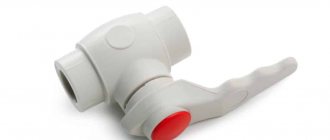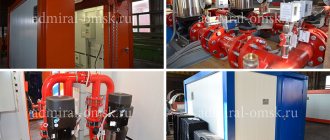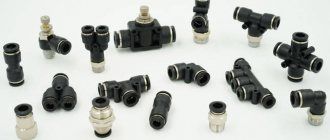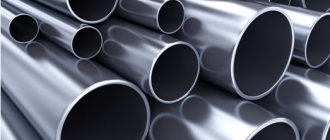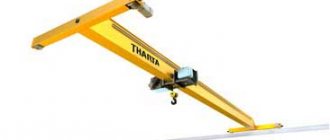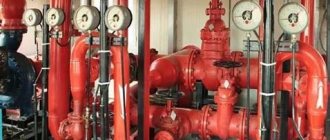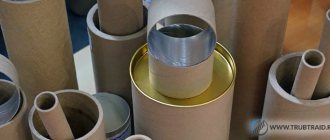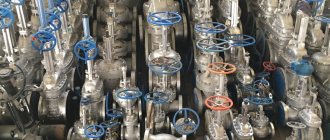Shut-off valves are used in heating networks, cold and hot water supply, and gas supply to shut off the flow of liquids and gases. At the same time, depending on the conditions of use, the transported working fluid and the overall dimensions of the pipelines, various types of ball valves are used.
For the average consumer who independently installs various types of household systems, there are many types of ball valves on the market. In order to choose a suitable model, you should know the distinctive features of ball shut-off valves, their scope of application, technical characteristics of the devices, and the decoding of alphabetic and numeric symbols on the body.
Rice. 1 Ball fittings in piping heating devices and equipment
Purpose and functions of shut-off valves
Shut-off valve products belong to a special type of products for pipelines, the purpose of which is to quickly regulate the flow rate of the working medium to ensure the specified parameters of the technological process. The action of shut-off valves is aimed at closing, opening, changing the direction and speed of movement of the working gas/liquid. In addition, shut-off valves should include drainage and control products that serve to discharge media from pipeline systems, technological devices, and supply media to control and measuring instruments.
Fittings of this type are present in all pipelines of industrial production, technical facilities for domestic purposes (heating, gas, water supply, sewerage, etc.), and make up at least 80% of the total number of products used in the pipeline. The most common types of shut-off elements are valves, valves, taps, flaps and closures.
The choice of materials from which these parts are made is currently quite wide:
- metals (titanium, aluminum);
- alloys (cast iron, steel, bronze);
- polymeric and synthetic materials, for example, polyvinylidene fluoride (PVDF), chlorinated polyvinyl chloride (CPVC), polyethylene (PE), polypropylene (PP).
When choosing a shut-off product, one is guided by the following technical characteristics: connecting diameter, purpose and material from which the body and working part of the pipeline are made, closing speed. Special requirements: long service life, high strength, reliability, safety, corrosion resistance of the material to the working environment, tightness, ease of installation and ease of operation.
It should be noted that the working environment of the pipeline quickly damages shut-off valve products, abrasion of sealing elements, wear, and corrosion processes occur, therefore it is necessary to carry out timely technical control of equipment, flushing of pipeline systems, repair or replacement of the product.
Depending on their purpose as part of a technical object, shut-off valves are divided into categories:
- industrial (general industrial, special) – used in production of various types of activities, including the national economy;
- ship - operated in the given specific conditions of sea and river transport;
- plumbing – pipeline fittings for household use, used in gas stoves, water heaters, bathrooms, boilers, etc.;
- custom manufactured – designed, manufactured and operated in accordance with specific specified technical requirements, for example, in unique, experimental industrial facilities.
The functions performed by this type of valve are extensive: control, distribution and mixing, safety, protective, shut-off, phase separating.
In this article we will consider the types of shut-off valves, the action of which is aimed at changing the cross-sectional area of the pipeline to regulate the flow rate of the medium or stop it completely.
How to choose a faucet
In order not to make a mistake when choosing a crane, you should consider a number of important points:
- Purpose of the device. In accordance with GOST, products for gas pipelines are identified by the black or yellow color of the handle, for cold water supply networks - by blue. Ball valves intended for hot water supply networks are marked in red.
- Part installation method. On highways intended for transporting acidic, alkaline media, or liquids with high temperatures, preference is given to devices for welding.
In addition to the nominal bore, the product marking contains information about the values of the nominal (PN) and operating pressure, the maximum permissible operating temperature, and the date of manufacture of the part.
When purchasing the device, you should carefully inspect it for defects - nicks, chips, dents. It is also worth checking the package, which must include:
- Frame.
- Steel or brass ball.
- Sealing washer.
- Control knob.
- Adjusting nut.
- Seal rod.
Also, you should be careful not to buy a low-quality fake made of silumin for the same money, which will last, at best, 2-3 years, instead of an expensive and durable brass product. You can recognize an attempt to deceive by its weight - real brass is very heavy.
To connect shower cabins, washing machines and dishwashers, and internal wiring of the water supply system, collapsible taps with threaded fastening are suitable. In general, when choosing between all-welded and collapsible parts, it is better to give preference to the latter, since they are easy to repair, easy to operate, compact, and are also characterized by a good level of tightness.
As for cost, this is not an issue where you should try to save money in any way. A cheap faucet of poor quality will not only last an order of magnitude shorter, but also has every chance of causing serious trouble - from flooding the neighbors below to a life-threatening gas leak.
As expected, the cheapest are the products of craftsmen from the Middle Kingdom, the most expensive are Italian devices. Russian cranes belong to the middle price category, offering a reasonable compromise between savings and quality.
Marking
If you carefully examine the ball valve, you can find some symbols on it. These signs carry a lot of useful information , such as tags on clothes. The ability to decipher this data will allow you to understand whether this device is suitable for you.
The application of markings is regulated by GOST R 52760. The document states that the manufacturer is obliged to indicate on a visible part of the product or on a separate plate the information necessary for the buyer. As a rule, the following data is indicated on ball valves:
- DN - directly, the diameter of the internal passage.
- PN is the maximum pressure value. As a rule, it is indicated in atmospheres.
- Values of design and working pressure.
- The material from which the ball valve body is made.
- One or more arrows indicating the direction of flow.
- The minimum and maximum temperature at which the device can operate.
- Date of manufacture.
Repair of fittings
There are three types of repairs:
- routine inspection;
- Maintenance;
- major renovation.
In the first case, the elements are cleaned of contaminants and preventative lubrication is performed. It is possible to wash the plugs from sand and other deposits that impair the tightness of the joint.
Current repairs are carried out at the place where the parts are installed. The area is first disconnected from the supply of working fluid. To clean the sealing elements, the fittings are dismantled and the seal is cut off using a knife. If there are scratches on the discs, they are removed with sandpaper and rubbed with a special paste.
Major repairs are carried out when complex defects are detected. The fittings are dismantled and repaired in the factory. For repairs, grinding machines and various laps are used. Abrasive pastes are suitable for restoring the connecting surface. After processing, the lapping materials are washed off and diamond grinding is performed. Elements that cannot be repaired are replaced with new ones.
Properly selected fittings are the key to trouble-free operation of a pipeline system of any complexity and purpose.
This is especially important when organizing oil and gas pipelines, high-pressure pipelines, industrial enterprises and energy complexes
In the video you can learn about the operating features and design of such products:
Views: 786
Design and principle of operation
The body of the shut-off device is a piece of pipe expanded in the middle part. The extension contains a seat made of sealing material, inside of which there is the main element - a ball, also known as a valve or plug.
The ball can rotate freely inside the seat. It has only one through hole in the shut-off valve.
Control devices and valves that redirect flow may have 2 or 3 holes. If the tap is used to regulate the pressure of hot or cold water, then there are two holes, if the device is a mixer, then there are three holes.
The ball valve is activated by turning a lever to which a ball valve with a hole is connected through a rod. By rotating the hole relative to the axis of the pipeline, we open/close the passage of the medium or partially let it through
The principle of operation is very simple: when the axis of the hole in the ball is aligned with the axis of the faucet body, water will begin to flow out of it.
Those. when the plug is deployed so that its hole coincides with the direction of the pipeline, as if continuing it. In this position, the flow of liquid, steam, gas passes through the pipeline, including through the tap, freely.
When the ball valve is turned 90º, the passage for water, steam, gas is blocked by the side on which there are no holes. In this position, the flow of the medium stops completely, because it rests against the solid wall of the valve.
However, with this simple device you can regulate the flow parameters. When turning 45º, for example, the flow will only be blocked by half.
To control the ball, a rod connected to a lever is used. There are o-rings on both sides of the rod. The hole in the body through which the rod passes is also equipped with a washer and an O-ring.
The single-lever ball mixer is equipped with a valve with two holes for the passage of cold and hot water and another hole for the exit of a mixed stream
Ball valves are made of brass or various grades of steel. Brass devices are considered more reliable, their service life exceeds 10 years. Steel products are very rarely used in everyday life; they are mainly used for industrial pipeline systems.
More recently, manufacturers began to produce cranes whose body is made of high-strength plastic. Unlike brass, such devices are not subject to corrosion and are much cheaper.
The only disadvantage of plastic products is that they cannot be used for hot water.
All o-rings are made of high-density rubber; these are the “weakest” points of the faucet, which cause leaks, but are easily replaced using a regular repair kit
These taps are most widely used in everyday life. A feature of their design is that the ball is not rigidly connected to the stem and can move under the influence of water, pressing against the sealing ring, thus sealing the tap.
A floating ball is used in mechanisms whose nominal size does not exceed 20 cm. Such devices are installed in internal water and heat supply systems. Almost all domestic and imported household faucets also have a floating ball mechanism.
The design of the valve body with a floating ball can be either welded or dismountable. Sealing elements can be of different hardness. Small household appliances are usually collapsible and have soft seals.
Floating valves are installed on pipelines with a diameter of up to 200 mm with constant movement of the working medium. The ball, under the pressure of the medium, is pressed against the sealing rings, sealing the fittings
There are valves in which the locking element is fixed on the axis of the stem, and the seals are pressed against the ball using tightening bolts or springs. To facilitate closing/opening, the trunnion is equipped with bearings.
This design is the most reliable, but due to its high cost it is used extremely rarely in everyday life and usually in the most critical areas of the water supply system.
Device Description
Why is the valve called a “ball valve”? The answer is simple - there is a metal sphere inside the device. When the valve is turned, it allows or prevents the passage of water or gas through the pipes. This type of locking device is especially popular in private houses or apartments.
Depending on the manufacturer, as well as on the purpose of use, the dimensions of ball valves may vary, so this must be taken into account when purchasing. But nevertheless, if we compare the sizes of modern products with those that were produced 10 years ago, then the current ones will be much more compact, more reliable and more functional than their predecessors.
Each device contains the following parts:
- Frame. It contains a metal sphere that prevents or facilitates the passage of gas or water.
- Screw-on part. Thanks to it, you can disassemble the ball valve if necessary.
- The working part, that is, a metal ball.
- Seals. In order for a metal sphere to fit tightly, various materials are required that contribute to this.
- Drive rod - reduces the effort when turning the valve.
- The control lever is the valve itself.
The safety factor of the products is designed for strong liquid flows that will constantly pass through the ball valve. Therefore, such devices can be safely installed even in the most “water-pressure” places.
Installation and operating rules
The design of the ball water tap makes it easy to install it yourself where it is required. The crane must be mounted in a place so that during operation it does not interfere or is not subject to mechanical stress.
At the same time, unimpeded access to the crane must be ensured in case of control of operation, correction of repairable damage and dismantling if replacement is necessary.
The locking device is installed on metal or plastic pipes according to the following algorithm:
The old faucet (if any) is removed and the threads are cleaned of any remaining tow and sealant. The threaded seal is wound tightly. A new, appropriately sized locking device is screwed on
Please note that the thread on which the product is screwed must not be rotten; it must have at least four turns. Otherwise, it is necessary to replace the entire pipe or part of it.
When installing a water supply system from scratch, first of all, you need to mark the place where the tap will be installed. Then the pipe is cut at this place, a corresponding thread is made, onto which the locking device is screwed.
Do you have a water supply system made of metal-plastic pipes? You can read about the types of pipe cutters for such a pipeline in our other article.
In both cases, before installation you need to pay attention to the arrow indicating the direction of flow and be sure to comply with this condition. Before screwing the tap, it is recommended to wrap the thread with FUM tape
This will ensure the most reliable sealing.
After installation, it is necessary to check the functionality of the locking device. To do this, you need to turn on the water and check for leaks, gradual formation of drops, or smudges. It is also necessary to make sure that nothing interferes with the control of the crane, i.e. the lever or “butterfly” has free movement.
Electric welding is used to install the device using the welding method.
During the welding process, it is important not to damage the ball mechanism and sealing rings
First, one pipe is welded, then the second, while on vertical sections the valve should be installed in the “closed” position, and on horizontal sections – “open”.
Using a fitting and a lock nut, a ball valve can be installed not only on a metal or plastic pipe, but also to connect pipes from different materials.
The operation of ball mechanisms does not cause difficulties; they are used either closed or open. It is theoretically possible to regulate water supply using a ball valve.
However, it is worth considering that such a faucet is, first of all, a shut-off device and too intensive use will lead to rapid wear of the seals. To regulate the flow, it is better to use ball mixers or a needle valve if it is impossible to install a mixer.
Do not install household taps where process water containing solid impurities passes through the pipes, because they will quickly damage the O-rings, rendering the locking device inoperable.
Before purchasing ball control valves for water supply installation, you need to check the plan and determine how many straight-through and rotary pieces will be required
Scope of application in households
The owner of an apartment in a high-rise building, the owner of an individual house, encounters ball valves in the following types of communications:
- Ball valves are responsible for shutting off the common cold and hot water supply line in apartments; they are installed next to water meters near sewer risers.
- Using ball valves, cold water is turned off and supplied to the faucet and toilet, placing them on the pipes in front of the flexible connection.
- Taps are also installed to turn off and supply water to washing machines and dishwashers.
- In any gas supply line, a gas shut-off valve is installed in front of the stove or other gas-consuming appliance.
- In heating systems, taps play an important role; with their help, they drain and fill the coolant, shut off the flow of liquid in front of water heating equipment and boilers, heat exchange radiators, circulation pump, expansion tank and other components so that they can be repaired, maintained or replaced without draining the working environment.
- In individual water supply systems, taps are used to shut off the water supply to the intra-house main, cut off various equipment from the pipeline, and supply water for watering plants.
Rice. 3 Main parts and physical characteristics of a typical crane
General information
Water taps are divided into two main types
- Faucets. Installed on sinks, washbasins, bathtubs, showers. I regulate the supply and mixing of water at one point.
- Shut-off valves are mounted on water pipes and perform the function of shutting off the system.
Valve taps
Stopcock with valve. In faucets with a valve or wing, a faucet-axle is installed inside, which shuts off the liquid. When the lamb unwinds, the crane axle box rises from the outlet hole and clears the passage. When the tap is turned on, it lowers and blocks the flow of water; to increase sealing, a rubber gasket is installed on it.
Crane parts
- Lamb (valve)
- Spindle
- Sealing nut
- Frame
- Washer with gasket
- Nest.
The body (often called a herringbone) has a spout in the center, and on both sides there are valves with tap axle boxes. One lamb controls the supply of hot water, the other cold. In the center the streams mix and fall into the spout.
Ball valve for installation on pipes.
The shutoff of water occurs thanks to a ball in which a hole is made in the center. When you turn the lever, the ball unfolds and a passage for water is formed in the center. When the lever returns to its original position, the ball unfolds, with the hole perpendicular to the pipe, and the entire spherical sides of the ball blocking the pipes.
Recommendation. The tap should be turned off smoothly, without sudden movements. This will help reduce the risk of water main damage.
Ball valve device
Ball valves are divided into:
- Full bore with equal diameters of pipe and valve
- Reduced. The diameter of the fitting is less than the cross-section of the pipe. Cranes of this type minimize the occurrence of water hammer.
Installation type
- Threaded. The thread can be either internal or external. The fitting is connected by a coupling or screwed into the pipe.
- Combined. There are two types of threads on the fitting. On one side it is external and on the other it is internal.
- Welded. The shut-off valve is welded to the pipeline.
- Flanged. A flange is a separate piece, round or square, with holes around the perimeter for bolts or studs. The flanges are welded to the pipe and fitting, and then they are connected using a sealed rubber gasket.
Ball single lever mixer
Manufacturers offer two models of the mechanism:
- Ball. Mixing and supplying water occurs thanks to three holes in the cartridge.
- Ceramic. Water supply and regulation is carried out thanks to polished metal-ceramic plates. The design of the crane is quite complex. The design is not very popular.
Touchless faucets
Such mixers have no lever or valves. They are triggered by a sensor. The sensor is triggered by the movement of an object. Models are divided into standard and high-tech. Standard faucets only supply water from a sensor. The parameters are set using levers installed on the body.
High-tech can be adjusted by gesture. Or have a touch panel on which the required parameters are set. Models are available with a remote control and many other additional functions.
The disadvantage of such mixers is their volatility, high cost, and if they break down, you will most likely have to buy a new device.
Technical characteristics and GOST requirements
To select a suitable product, you need to know the frequency of use and its purpose. Thus, shut-off valves with a diameter of 1-1.5 inches are suitable for infrequent use and are not designed for constant high loads. Otherwise it will fail.
For household purposes, elements with a diameter of 0.5-0.75 inches are suitable. 0.5-inch taps are used for installation on water supply pipes, and 0.75-inch products are used for heating systems with a circulation pump.
Large diameter models are suitable for production purposes or special uses. For domestic needs, fittings measuring 0.5-1.5 inches are sufficient.
The best materials and manufacturers
The metal or alloy from which the ball valve is made plays a significant role in its use. Poor quality material can break the device in the shortest possible time. As a result, a broken product will cost financially to replace it.
Typically, ball valves are made from brass or nickel plated brass. These materials have proven themselves to be excellent over time. However, it is not recommended to purchase products made from silumin. Faucets made of silumin can crack or literally fall apart during installation, especially if they were made by an unscrupulous manufacturer.
ValTec is undoubtedly the leader in the ball valve market. It has long established itself as a high-quality and reliable manufacturer of plumbing fixtures. Therefore, first of all, it is worth focusing on the products of this company.
If there are no models from ValTec, you can purchase devices from Bugatti. It is also of excellent quality , but is present on the plumbing market less than its competitor. Domestic manufacturers also want to become leaders. For example, the Bologovsky reinforcement plant, which, after “stagnation,” is trying to make up for lost time due to low prices and high-quality products.
The great demand for ball valves has had a significant impact on the variety of products, the level of competition and the quality of products. But, despite the wide choice, it should be remembered that for each purpose there is a tap of a certain size. Therefore, when purchasing, you must be guided by this principle.
Purchasing a product of the wrong diameter can cost nerves, time and possibly money. Therefore, when choosing a model for heating, you should not aim for dimensions of 1-2 inches. Otherwise - a return request, unnecessary legwork and again searching for a suitable product.
What parameters are important when choosing a ball valve?
Many of our customers are faced with the need to install a ball valve on site, but they do not have a brand. In this case, we can select the valve you need. Let's consider what parameters are important when selecting a check valve. — valve diameter, DN
- usually it coincides with the diameter of the pipeline.
Standard range of diameters in millimeters and inches: 6, 8, 10 (3/8 inch), 15 (½ inch), 20 (¾ inch), 25 (1 inch), 32 (1 ¼ inch), 40 (1 ½ inch) ), 50 (2"), 65 (2 ½"), 80 (3"), 100 (4"), 125, 150, 200, 250, 300, 350, 400, 450, 500, 600, 700, 800mm . — nominal valve pressure, Ru
— Standard range of pressures: 10, 16, 25, 40, 63, 100, 160 kgf/cm2.
When choosing a nominal pressure, it is worth considering the fact that for stable and long-term operation of the faucet it is necessary that the operating pressure be 2 times less than the nominal one. For example, the pressure in your pipe is 12 kgf/cm2. It is necessary to install a tap at 25 kgf/cm2. If you set the tap to 16 kgf/cm2, then within a few months the tap may fail. - body material
- features of the body material of various valves are described in this article in paragraph 3.
- type of connection
- features of the body material of various valves are described in this article in paragraph 4.
- valve design
- design features of ball valves are described in this article in paragraph 8.
- seal in the valve
- the features of the seals of various taps are described in this article in paragraph 7.
- equipment manufacturer
- this is a very important parameter, because there are now a lot of low-quality Chinese handicraft taps on the market, which seem to suit all parameters, but in the process operation cause so many headaches that savings come at a cost. The second extreme is that many European and American brands try to sell their equipment at 3-5 times more expensive than a normal quality product. What should an ordinary buyer do? In this case, it is advisable to get advice from people you trust - plumbers, installers, reputable sellers.
Basic criteria for choosing equipment
If there is a question about replacing the gas tap, then doing it yourself is not recommended. Only specialists have the right to engage in such work, and they must have a license for these types of work. Replacing gas pipes and taps yourself is simply unacceptable. You can endanger not only your life, but also the lives of your family and neighbors.
Every homeowner and tenant should know this information. It is the gas workers who carry out periodic inspections of the condition of gas equipment or, in case of problems, the owner of the property calls the emergency gas service. They, in turn, determine what is out of order, and residents buy everything they need to fix the breakdowns. In this case, we will find out what criteria are best for choosing a gas tap.
As previously mentioned, ball valves are popular, although experts in this industry say that plug valves last longer - their service life is about 20 years. They just need to be maintained and occasionally lubricated. But ball ones - no.
So when choosing, you should pay attention to all the little things, even the appearance of the product and take into account the following circumstances:
- The diameter of the gas valve must match the diameter of the pipe. Of course, valves of smaller or larger diameters are simply not suitable for the job.
- Thread pitch. If you take a threaded locking mechanism, then it must match the thread pitch on the gas pipe. This way you don’t have to buy any adapters that will bulk up the structure.
- Pay attention to the material of the product. Still, for gas it is better to use taps made of brass. This is time-tested material. It will serve you for a long time and without problems. Brass has a yellowish tone and a brass faucet is heavier than various types of steel.
- Look carefully at the appearance. The product must be free of scratches, cracks and chips. There should be no defects either on the surface or inside. Don't hesitate to take a close look at the gas valve; you don't want to change it often. You should also not save on your purchase.
Choose faucets from well-known companies, as these manufacturers take responsibility for their products because they do not want to lose customers. And the reputation of their company is important to them. Such manufacturers include the German company Dungs and the Italian company Bugatti.
Types of ball valve
There are two main types of ball valves:
- Full bore
. The inner ball in this type has a hole, the diameter of which corresponds to the cross-section of the pipeline itself. This makes it possible to reduce hydraulic losses compared to other types of shut-off valves. - Standard bore or reduced
. The hole in the sphere of such a device is one size smaller than the diameter of the pipe. Such a gas ball valve is installed where partial loss of pressure is allowed.
According to the direction of flow and the number of pipes, they are divided into:
- Angular
_ They are used when working in bends and hard-to-reach areas. - Passing
. The most common option that does not change the direction of flow. - Three-way
. They have two inlets and one outlet. They are used for installation on branched lines when it is necessary to mix different media. - Multi-pass
. Capable of connecting even more streams and mixing their contents.
Union ball valve
Such products are equipped with internal conical or cylindrical threads. As a rule, a ball valve with a union nut is installed on pipes whose diameter varies from 1.5 to 4 cm. The main area of application is public utilities. They are installed in houses and apartments on pipes with hot and cold water, a battery, etc. Installing and dismantling such a faucet is easy and simple, it is lightweight, easy to use, and the owner can choose the position of the handle that is comfortable for him - this will not affect the operation of the control mechanism in any way.
Flanged ball valve
This type is chosen in cases where partial disassembly and assembly of the pipeline, as well as its connecting elements, is provided. Gas ball valves of this type are also installed in those rooms where welding is prohibited. They are able to work even in polluted, muddy environments, which largely determines their scope of application. Such shut-off valves are attached to the pipeline using special plates - flanges. They are tightened with nuts and bolts or nuts and studs. Such an angle ball valve can be mounted and dismantled.
Welded ball valve
This type is used in production where there is a critical or hard-to-reach section of the pipeline. The weld-on ball valve provides the ceiling with complete tightness and ensures a strong and reliable connection. This product has proven itself in the transportation of liquid, steam and gas media, oils. Such shut-off valves do not require maintenance or preventive maintenance, therefore they are often used on main lines and remote sections of communications.
Combination ball valve
This is a universal product that can be used in all of the above areas. On one side it may have a coupling connection, and on the other, a flanged or welded connection. This is a more expensive variety, which is a combination of the three models described above. Full bore ball valves are used everywhere - in the gas industry, hot and cold water supply, heating systems, food, chemical and other fields. The absence of stagnant zones makes it possible to operate these shut-off valves in viscous media.
Classification of gas taps
Since childhood, we were taught that we should not joke with gas. Even now, every schoolchild knows the telephone number of the gas service: 104. At school, from early childhood, they explain where to call if the smell of gas is heard in the house.
Pipes, valves and other component materials for gas supply must be of special quality. These structural elements must serve a person for at least ten years, and they should be periodically checked and, if necessary, replaced.
However, the owner of the premises will have to purchase gas equipment himself. Choosing it will not be difficult if you study what requirements it must meet. Thus, the main characteristics of gas taps almost all boil down to the reliability of the valves. Dimensions depend on the diameter of the pipe. That is why the diameters of gas taps must match the size of the pipe.
Most often it is 24, 27 mm. Manufacturers produce gas valves and valves; the thread size of gas taps can be of three types. If you look at the product labeling, then according to GOST the following information must be indicated: type of product and type of tap
According to the operating principle
Next, we will consider what types of gas valves there are. Judging by the principle of operation, they can be divided into cork and ball.
Plug gas valves - their operating principle is based on the operation of a plug mechanism. The principle is quite simple: just turn the tap handle and the plug will also turn inside the body. And there is a hollow structure, thanks to which gas can easily pass inside the housing through the pipe to its destination.
When the valve handle is turned back, there will already be a closed space there and therefore the gas will no longer pass through the obstacle. The only thing is that the valve body and the plug must fit tightly against each other. The role of the sealant is performed by the valve seal.
Ball gas valves are somewhat different from plug valves in that there is a ball inside, which plays the role of a shut-off system. If the ball is turned in one direction, gas will pass through the hole in it, thus opening the valve. If in the other direction, then the closed surface will not allow gas flows to pass through. Usually such a ball is made of metal. Moreover, the material used is durable.
The product lasts for a long time and does not require special care for a ball valve, unlike a cork valve, which requires periodic maintenance. Ball structures appeared on the markets not so long ago, but they are especially popular, because they have their own advantages. In particular, the low cost of the product, ease of use, strength and reliability, and long service life.
These taps can also be operated at low and high temperatures, more precisely within the range from -55 to +75 degrees Celsius. That is why experts advise using just such gas taps for domestic purposes.
By pipe connection method
If you look at the method of connecting taps to pipes, they can be divided into the following types:
- taps with a threaded connection - they are connected to the pipe by twisting until full contact. To prevent gas from poisoning, special gaskets are used;
- faucets with flange mounting - they are connected with special flanges, which are metal disks, but they are already secured with bolts;
- taps with a welded connection method - such locking mechanisms are simply installed using a welding machine, without any threads or flanged auxiliary disks and bolts.
The valves of the first two fastening methods (threaded and flanged) can be used reusably; they can be removed from the pipes and then attached back. But welded mechanisms are used only once; repeated use is impossible.
According to product material
When purchasing a gas tap, it is imperative to pay attention to the material of the product. This is an important component, because the stronger the material from which the locking mechanisms are made, the longer its service life. And for gas pipes, taps must be of the highest quality.
It is from the raw materials from which the taps are made that they got their names. Brass taps are perhaps the most common products on the market.
True, these designs also have some disadvantages. If you need a tap for supplying gas to a stove or boiler, then yes, you will find such taps made of this material. For small diameter pipes there is a small selection of products, and not for everyone. Brass also reacts to high temperatures. If you heat the product above 200 °C, then it will no longer be possible to use it. Brass is also not used in the petrochemical industry.
In addition, many manufacturers have recently replaced brass with brittle silumin in order to save money and do not always warn about this, so the buyer should be careful about the products, choosing them in those places where there is no product certification. silumin taps can leak gas due to microcracks; this is unacceptable and unsafe.
In the USSR, cast iron gas taps . The quality of these products was excellent, but now manufacturers have stopped producing them, because this industry does not stand still, but is developing. New types of steel are appearing, which are not as expensive as cast iron, but have properties similar to it. That’s why they don’t make cast iron mechanisms to control gas supply anymore.
Nowadays, in addition to brass products, you can often find:
- Carbon valves - they have a huge variety of diameters, but they are most often used for water; they are not suitable for supplying even slightly aggressive media. Also, if the temperature is minus forty, then the material loses its properties and is not suitable for use.
- Alloy taps are quite similar to carbon taps in terms of type of application, their only difference is that they can withstand temperatures down to – 60 °C.
- Stainless steel taps are more often used in large industries. They are resistant to different temperature changes, are not afraid of aggressive environments, and do not rust.
Polypropylene taps
When using plastic pipes, it will be more aesthetically pleasing to use taps coated with polypropylene. This is usually what inexperienced plumbers think about. In fact, it is better to use regular brass taps with a transition to polypropylene through a coupling.
At first glance, a faucet filled with a polypropylene shell seems to be the ideal solution. Does not spoil the overall appearance of the plastic pipeline, does not require additional parts for connection to a common unit.
The fact is that taps filled with plastic have lower reliability. The faucet consists of two fundamentally different materials (metal and plastic), with different densities and thermal expansions. Due to different properties, problems often arise in the form of leaks or breakdowns. Global manufacturers recognize the shortcomings of polypropylene cranes and are working on the mistakes, but it is too early to say with complete confidence about reliable cranes of this type.
A much more reliable solution would be a brass tap with two threaded couplings. The coupling also contains two materials, metal and plastic, but these parts are stationary, unlike a tap.
In addition to reliability, there is also an aesthetic side to using conventional taps: the tap can be rotated along its axis and given a more even position. The sealed plastic tap cannot be turned on the pipe; you need to do the soldering very clearly the first time; the soldering can only be corrected by soldering in a new tap.
In fact, brass faucets provide more options. They can be replaced without soldering, if the faucet comes with an American one; the connection is detachable in case of other repairs. American becomes relevant when installed in hard-to-reach places.
In addition, conventional cranes are, as a rule, smaller in size, and the range of products is much wider.
Just like brass, polypropylene taps come in two types: valve and ball
Please note that ball valves can only be used in two positions: open and closed, adjustment is not allowed. All manufacturers say so
However, on this score, in the process of working as a plumber, a different opinion was formed...
The above is true for expensive, high-quality products, but in our realities, as a rule, we have to deal with budget faucets. So, if we compare two budget products, a valve and a ball valve, the ball wins in terms of reliability, even with constant adjustment. Although the valve is specifically designed for regulation, it fails very quickly. This opinion has been formed over many years of work. These considerations are valid both for brass shut-off and control valves, and for products filled with polypropylene.
And finally, I would like to say: you should not skimp on taps, as well as on all plumbing fixtures. Pipes and all components should be purchased from reliable stores; this should be done slowly and thoughtfully!
Tips for replacing gas taps
In apartments or houses, gas communications last for many years. The only thing is that they require periodic inspections and maintenance (painting of pipes). The most vulnerable parts of such structures are gas valves. Of course, they are used several times a day, or even more. It is due to heavy loads that gas valves break. Breakdowns of gas taps made from low-quality raw materials occur especially often. Plastic products break down faster than others.
Not everyone knows when the faucet needs to be replaced. The answer is simple - when you smell an unpleasant aroma characteristic of gas, you need to check where the smell is richest. If the leak is in the gas valve area, then it should be replaced.
Inspect the product, you may notice cracks or other damage on it. Maybe the tap turns tightly or, on the contrary, turns too freely, then we can safely say that the device is out of order. But you cannot replace the locking device yourself. Don’t tempt fate - call a gas service worker.
It will replace your gas tap for free, your only task is to buy the right mechanism that will fit your gas pipes and will last for many years. We described the selection rules above.
If there is a need to change the device, do the following:
- First, dial the number of the gas utility and report your problem to the dispatcher.
- Buy a suitable faucet, take into account the diameter of the pipes, thread pitch, and other nuances. Don't choose the cheapest product.
- Prepare documentation for gas specialists. Most likely you will need: a technical passport, gas supply documentation.
- When the employee arrives, he will ask you to light the burner and close the valve that controls the gas supply. This will allow the fuel to come out of the pipe.
- All work on replacing or repairing gas equipment must be carried out in a well-ventilated area.
- The technician will replace the tap and check its operation, and he must also check for gas leaks.
- When the repair of gas communications is completed, the specialist will ask for a technical passport and make a record of the work done.
A natural fuel leak is detected by using soap foam. Foam is applied to the joints and faucet, and then the foam is carefully monitored. If there is a gas leak, bubbles begin to form in this area.
Structural differences
The valve is designed in such a way that the working medium inside changes its direction twice, bending at a right angle, thereby increasing the hydraulic resistance. The main structural elements are:
- spindle;
- yoke knot;
- spool
When the device is activated, the locking mechanism, moving in the direction of flow, sits on the saddle. This is the fundamental difference between a valve and a tap. At the moment of closing, the sealing surfaces do not experience friction, which helps reduce the number of scuffs.
The seal of the moving joint can be stuffing box, bellows, or membrane (diaphragm). The use of non-metallic sealing rings improves the tightness of the joint and prevents the possibility of leakage.
The valve consists of a body, a plug (gate) with a through hole for the passage of the transported product. When the handle is turned 90⁰, the flow of the medium completely stops. There are three types of device:
- passing - the movement of matter remains unchanged;
- angular - change the direction of flow at a right angle;
- three-way - equipped with one outlet and two inlet pipes, they connect liquids of different temperatures into a stream. They are used for plumbing needs (faucets).
The devices also differ in appearance. The valve handle is presented in the shape of a “lamb”. The faucet is equipped with a simple handle attached to a stem.
The body of both devices is made of steel, cast iron, bronze, and brass. The material is selected based on operating conditions. Steel products are characterized by increased wear resistance and resistance to temperature deformation. Cast iron analogues are resistant to corrosion. Brass - used when working with non-aggressive environments. Bronze - have high strength and anti-friction properties.
